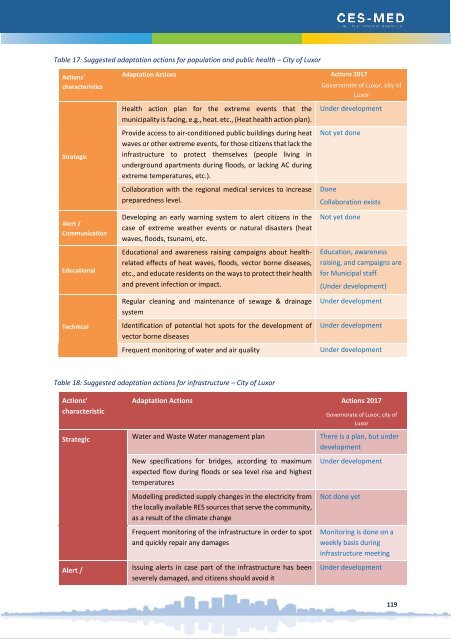280218_Luxor-Egypt SECAP Final_revised
You also want an ePaper? Increase the reach of your titles
YUMPU automatically turns print PDFs into web optimized ePapers that Google loves.
necessary adaptation policies. Providing job opportunities in safe areas (in locations that are not<br />
impacted by CC) is an important priority to successfully absorb the affected population.<br />
6.2.2.3 Agricultural Security<br />
Changing sowing dates and good management practices are among the important adaptation<br />
measures oriented to mitigate climate change. Changing cultivars to those that are more tolerant to<br />
heat, salinity and pests, and changing crop pattern are the most promising adaptation measures at the<br />
national level.<br />
Moreover, using different multi-level combinations of improved surface irrigation systems and<br />
applying deficit irrigation are successful means of increasing surface irrigation system capacity in<br />
traditional lands to overcome the negative impacts of climate change.<br />
For the livestock, improving the current low productivity of cattle and enhancing feeding programs are<br />
being considered. There is an urgent need for further studies on the impacts and adaptation to climate<br />
change in the agricultural sector in order to develop an adaptation strategy that would overcome the<br />
barriers for implementing adaptation measures. These barriers include limited scientific information<br />
and strategic visions, and lack of financial support.<br />
6.2.2.4 Additional Adaptation Policies and Measures<br />
According to the INDCs of November 2015, <strong>Egypt</strong>ian authorities are currently focusing on the following<br />
additional policies and procedures:<br />
− Building institutional capacities of comprehensive collection and analysis of monitoring and<br />
observations and geographic data;<br />
− Identifying indicators and conducting an assessment of vulnerable sectors and stakeholders;<br />
− Enforcing environmental regulations;<br />
− Identifying and applying protection measures of vulnerable touristic and archaeological sites<br />
and roads against extreme natural phenomena such as floods, dust storms and extreme weather<br />
conditions;<br />
− Building capacities for using regional water circulation models;<br />
− Proactive planning and integrated coastal zone management, and<br />
− Risk reduction and increasing awareness of stakeholders for energy and water utilization.<br />
Coastal Zones:<br />
National Adaptation Action Plan<br />
1. Reduce climate change associated risks and disasters.<br />
2. Capacity building of the <strong>Egypt</strong>ian society to adapt to CC risks and disasters.<br />
3. Enhance national and regional partnership in managing crises and disasters related to climate<br />
change and the reduction of associated risk.<br />
Water Resources and Irrigation:<br />
1. Increase investments in modern irrigation systems.<br />
2. Cooperate with Nile Basin countries to reduce water evaporation and increase its capacity.<br />
3. Develop national policies to encourage citizens on water use rationalization.<br />
113

















